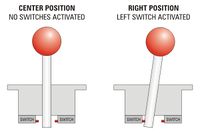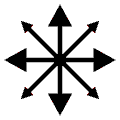Joysticks
Contents
Conventional Digital Joysticks
Conventional joysticks are fairly simple devices without which Pac-Man would be ghost-fodder. When the joystick shaft is moved in any direction, the lower end of the stick is levered in the opposite direction and makes contact with switches, these switches are what tells Pac-Man to move and in which direction.
By using four switches at the base of the joystick, 8 directions can be achieved; Up, Down, Left and Right as well as the four corner positions. Joysticks like this are known as 8-way.
Some joysticks were designed to restrict the player from moving diagonally; for example, joysticks used in Pac-Man and Donkey Kong. Though it is possible to use an 8-way joystick for these games, it's not recommended, as accidentally hitting a diagonal with the joystick will cause Mario to stand still and Pac-Man won't know if he should go up or to the side. Joysticks like this are known as 4-way.
- 2-way joysticks
- 4-way joysticks
- 8-way joysticks
Non-Conventional Digital Joysticks
- Mag-Stick
- Mag-Stick Plus
- Euro-Stick
49-Way Joysticks
Once used in a small handfull of Williams, Midway and Atari games, these analog style joysticks have become a great all-around stick when used on a home arcade machine. Using the GP-Wiz's various DRS modes, these joysticks can be easily switched between 49-way, 8-way, 4-way, 2-way and diagonal (Q*Bert style) modes without having to physically change the joystick hardware. This makes them well suited to a huge list of games that were originally controlled with different control methods.
Relevant links:
What are 49-Way joysticks? by URebelScum

